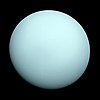Ferdinand (moon)
| Discovery | |||||||
|---|---|---|---|---|---|---|---|
| Discovered by | Matthew J. Holman John J. Kavelaars Dan Milisavljevic Brett J. Gladman | ||||||
| Discovered in | August 13, 2001 | ||||||
| Orbital characteristics | |||||||
| Mean radius | 20,901,000 km | ||||||
| Eccentricity | 0.3682 | ||||||
| Orbital period | 2887.21 d | ||||||
| Inclination | 170° (to the ecliptic)[1] | ||||||
| Is a moon of | Uranus | ||||||
| Physical characteristics | |||||||
| Mean diameter | ~20 km (estimate)[1] | ||||||
| Surface area | ~1300 km2 (estimate) | ||||||
| Volume | ~4000 km3 (estimate) | ||||||
| Mass | ~1.3×1015 kg (estimate) | ||||||
| Mean density | ~1.5 g/cm3 (estimate) | ||||||
| Surface gravity | ~0.0025 m/s2 (estimate) | ||||||
| Escape velocity | ~0.0055 km/s (estimate) | ||||||
| Rotation period | ? | ||||||
| Axial tilt | ?° | ||||||
| Albedo | 0.04 (assumed)[1] | ||||||
| Surface temp. |
| ||||||
| Atmospheric pressure | 0 kPa | ||||||
Ferdinand is the farthest retrograde non-spherical moon of Uranus. It was found by Matthew J. Holman, John J. Kavelaars, Dan Milisavljevic, and Brett J. Gladman on August 13, 2001 and given the designation S/2001 U 2.
Despite being seen again on September 21 and November 15 and even a year later on August 13 and September 5, 2002, it was eventually lost. It was finally refound on September 24, 2003 by Scott S. Sheppard on images taken by David C. Jewitt and himself on August 29-30 and September 20 of that year. Confirming observations were made by Holman on September 30.
Designated Uranus XXIV it was named after the son of the King of Naples in William Shakespeare's play The Tempest.
Orbit[change | change source]

Ferdinand is the farthest known moon of Uranus. It follows a retrograde, fairly inclined but very eccentric orbit. The diagram illustrates the orbital parameters of the retrograde non-spherical moons of Uranus (in polar co-ordinates) with the eccentricity of the orbits represented by the segments extending from the pericentre to the apocentre.
Related pages[change | change source]
References[change | change source]
- ↑ 1.0 1.1 1.2 Scott S. Sheppard, David C. Jewitt, and Jan Kleyna An Ultradeep Survey for Irregular Satellites of Uranus: Limits to Completeness, The Astronomical Journal, 129 (2005), pages 518–525 . Preprint

